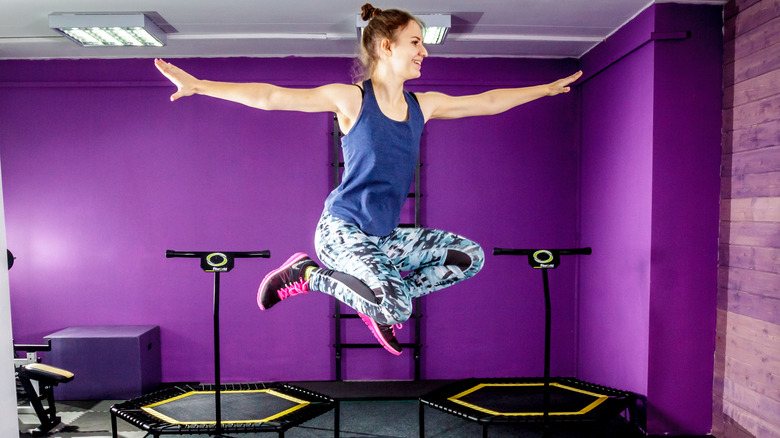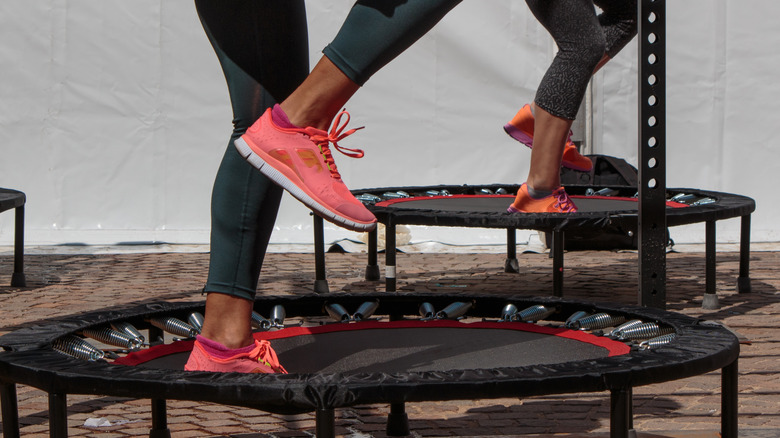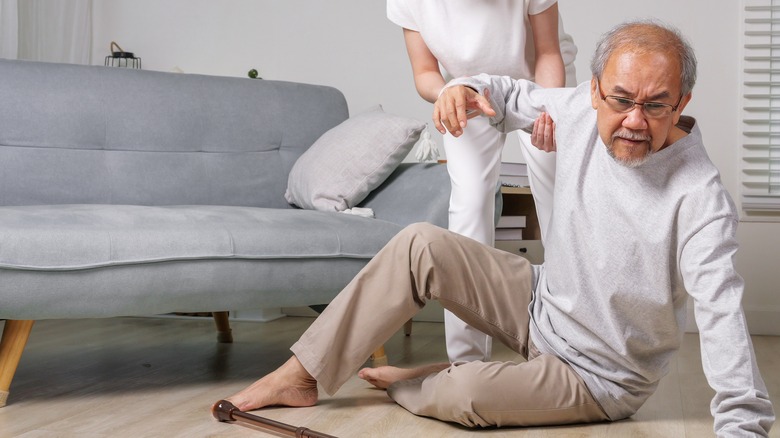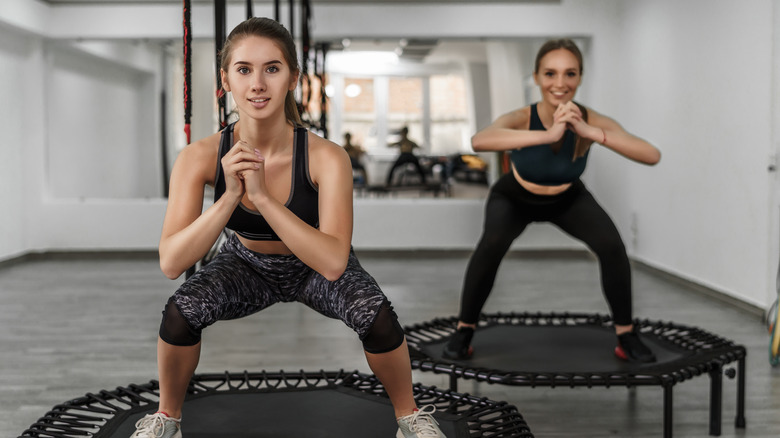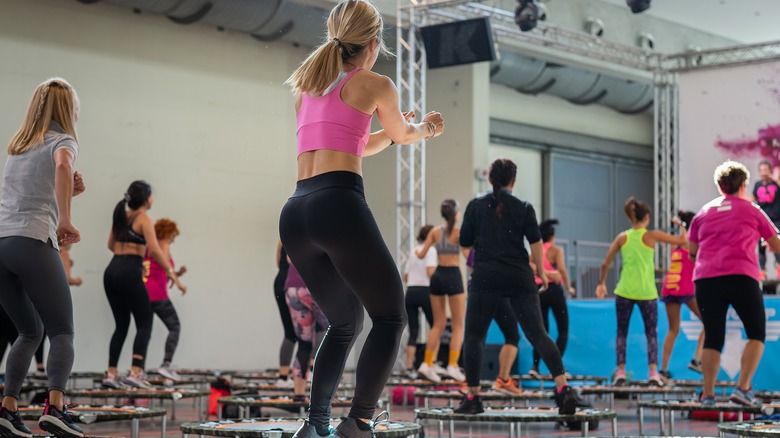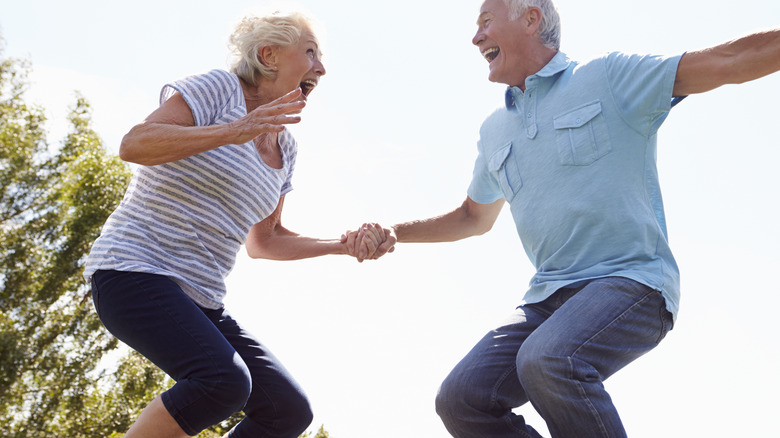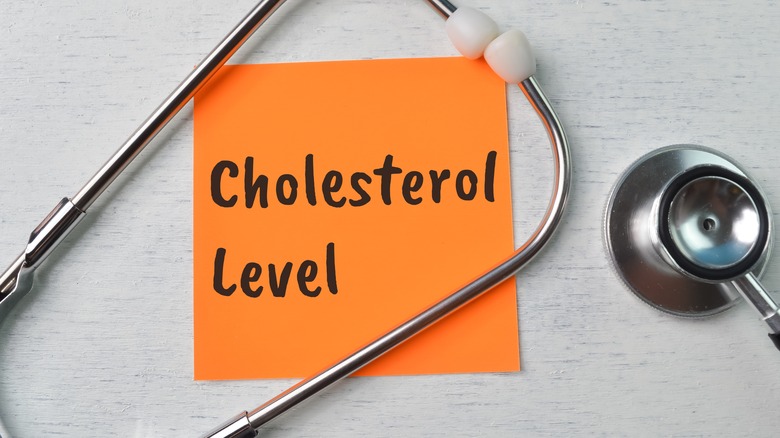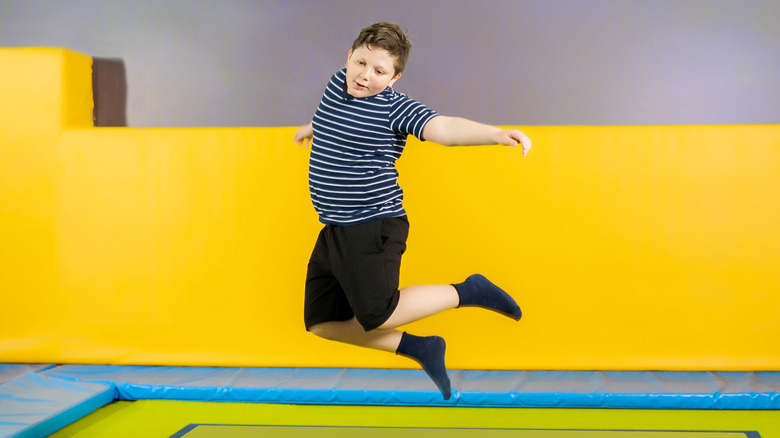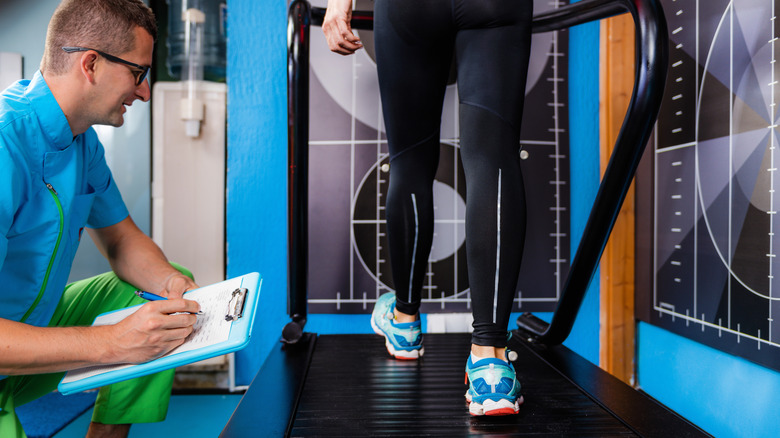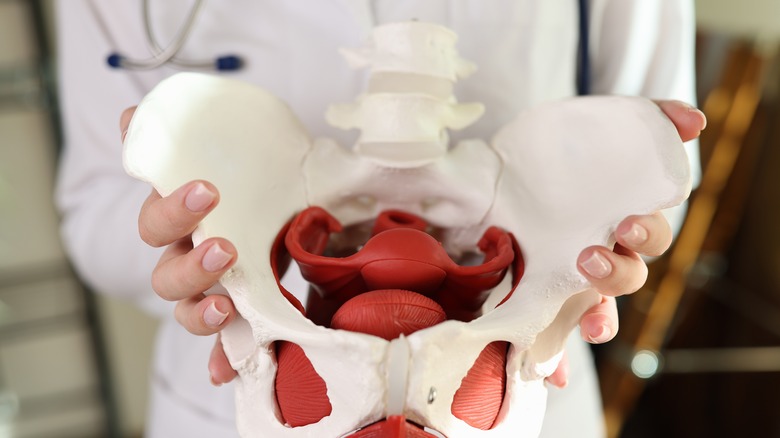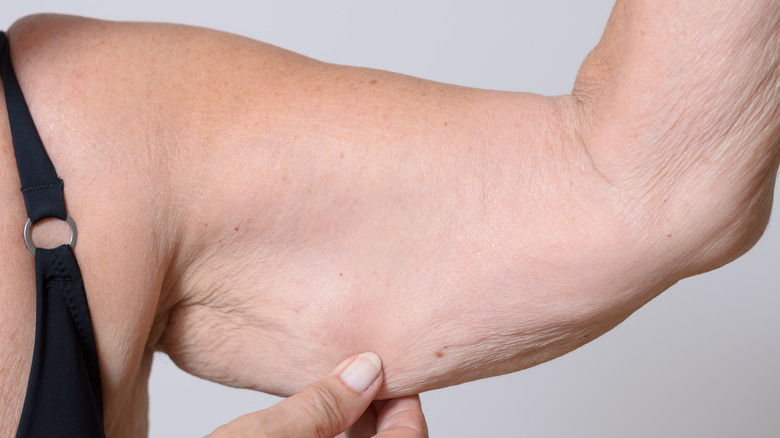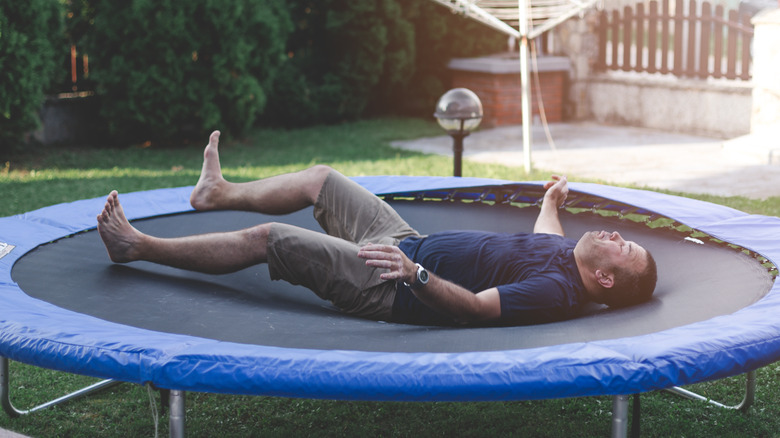9 Reasons You Should Add A Trampoline To Your Fitness Routine
Since the coronavirus pandemic, more people have become accustomed to working out at home. One home workout that has seen a revival in popularity is trampoline training (via USA Today). Even celebrities such as Eva Longoria and Goldie Hawn are having fun while getting a great workout on their trampolines. Working out on a trampoline, or rebounding, became popular in the 1980's when NASA found that rebounding was as effective as running on a treadmill for aerobic fitness, and without stressing the joints.
Trampolines come in different sizes, notes WebMD. While mini trampolines are suitable for adults who just want to do jumping exercises, less restrictive larger trampolines are great for kids who can have fun bouncing around and falling. Hopping, knee jumps, jumping jacks, and the twist are some favorite types of trampoline exercises. Benefits of trampoline jumping include improved cardiovascular fitness and muscle strength as well as weight loss and stress relief. As a low impact activity, rebounding puts less stress on joints in the legs, thus minimizing injuries. Exercising on a trampoline can also improve your balance and coordination. Safety precautions (e.g., netting and pads on metal parts) are of utmost importance to prevent injuries.
There is no set rule for how long and how frequent rebound workouts should be, reports Healthline. Benefits can be achieved with as few as three workouts per week and as brief as 15 to 20 minutes per rebounding session.
Types of trampoline exercises
As with any exercise, a warmup is important to get blood flowing to your muscles, notes Healthline. For the trampoline, a few minutes of light jumping should do the trick. There is actually a special technique involved in trampoline jumping to help you stay grounded: Stomp down on the trampoline with sufficient force to propel you to a height of about one to two inches off the mat.
First, jog in place by lifting your knees a couple inches, while staying straight up or leaning back a bit. Your arms should swing back and forth at your side. Eventually, you may progress to higher knee lifts; you can advance further by moving around more, side to side, with arms pumping higher, as you continue to jog away. This advanced jogging involving greater movement and engages a wider variety of muscle groups.
Jumping jacks are a bit more challenging. Stomp down as you lean slightly forward and jump your feet apart and then back to the starting position. Raising your arms to shoulder height is sufficient. The pelvic floor bounce involves placing an exercise ball between your knees and then slowly jumping up and down. Squeeze the ball to work your inner thigh muscles and build up to 2 to 5 minutes total.
As you build up strength and endurance, you may wish to incorporate intervals consisting of alternating 20 seconds of vigorous jumping with 10 seconds of rest. Holding light hand weights (2-3 pounds) while jumping is another option.
It helps improve balance
As part of the aging process, many older adults experience problems with balance and coordination (via a 2019 study published in Clinical Interventions in Aging). This affects their ability to safely move about and also increases the risk of falling and getting injured. Older people with osteoporosis and osteopenia (low bone density) are especially prone to fractures resulting from falls. At the age of 50, women have (on average) up to a 50% chance of having a osteoporosis-related fracture over a lifetime. In people with low bone mineral density (BMD), resistance exercises and other physical activities can help improve balance.
The loss of static balance — the ability to balance oneself while just standing — is an important risk factor for falls in older adults with osteopenia. A one-leg-stance (OLS) test is used to measure static balance. An individual undergoing this test must alternate standing on each leg for as long as possible, but not longer than 30 seconds. Older women with osteopenia who completed a 12-week exercise program on a mini trampoline were evaluated for balance and other parameters of physical function. Balance exercises included static exercises such as one- and two-legged stance, lunges, shifting weight while standing, and walking in place. Per the trial results, static balance significantly improved in the women doing the trampoline workout, but did not change in the control group that did not exercise.
Trampoline jumping builds muscle strength
Muscle strength also diminishes with advancing age (via a 2019 study published in Frontiers in Physiology). Age-related loss of muscle strength is much greater than loss of muscle mass and increases the risk of hospitalization, disability, and death. Maintaining both upper and lower body strength as you age is especially important for normal daily functioning and independent living, notes a 2019 study in Clinical Interventions in Aging. Resistance training is the exercise of choice to improve muscular strength.
The 2019 study involving older women with osteopenia also evaluated changes in muscular strength. Overall upper body muscle strength was assessed with an arm curl test, in which the women curled a 5-pound dumbbell as many times as possible in 30 seconds. Lower body strength was evaluated with a 30-second chair stand test. Participants were instructed to complete as many full stands from a chair as possible in 30 seconds. Strength exercises performed on the trampoline included squats, flexion and extension of the elbow joint, moving arms and legs toward and away from the center of the body, and range of motion movements of the shoulders. As with balance, muscular strength improved as a result of exercising on the trampoline. Compared to the non-exercising control group, participants who worked out performed significantly more arm curls as well as significantly more stand-ups from a seated position.
It improves aerobic fitness
Rebounding on a mini trampoline is a fun way to exercise for people of all ages, but does it actually improve aerobic fitness? According to research sponsored by the American Council on Exercise (ACE), working out on a mini trampoline delivers the goods.
Trampoline jumping measured up to the Amercian College of Sports Medicine (ACSM) guidelines for improving cardiorespiratory fitness. In the study, 24 healthy college students performed a 19-minute full body workout routine on a mini trampoline. On average, heart rates were 79% of maximum heart rate and VO2 (oxygen uptake) was 59% of VO2 max. These results are in line with the ACSM recommendations of 64-94% and 40-85% for maximum heart rate and VO2max, respectively. Thus, trampoline workouts provide enough intensity to enhance long-term cardiorespiratory fitness.
Exercising on a trampoline may favor ongoing compliance because the perceived exertion of the participants was lower than expected for a moderate to vigorous workout. This may be attributed to a more comfortable and enjoyable, though still effective, workout. During the entire workout (including warm-up and cool-down), men burned an average of 11 calories/minute while women burned an average of 8 calories/minute. Again, these rates are consistent with ACSM guidelines of 6.7 to 10 calories/minute. For the sake of comparison, the calorie burn from the trampoline workout approximates that of running at a 6 mile per hour clip (flat surface) or biking at 14 miles per hour, as well as playing a game of football, basketball, or ultimate Frisbee.
Trampoline jumping can increase bone density
Bone is constantly being turned over whereby old bone is degraded (resorption) and replaced by new bone (via a 2022 study published in the journal Biology of Sport). Cells called osteoblasts lay down new bone, while other bone cells (osteoclasts) function to break down bone tissue. Bone loss occurs when the balance between bone resorption and bone formation shifts in favor of bone resorption. Bone loss and the development of osteoporosis is more prevalent in women than in men. Studies have established that weight-bearing exercise increases bone mineral density (BMD) and bone strength and helps to prevent falls and fractures.
Jumping-type exercises have been shown to promote bone formation and increase bone strength in postmenopausal women. What's more, competitive female gymnasts who specialize in trampolining have stronger and denser bones relative to athletes performing other forms of gymnastics. In a randomized controlled trial, 24 women with regular menstruation were divided into an exercise group and a non-exercise control group. In the intervention group, 12 women performed jumping exercises on a trampoline three times a week for 20 weeks. The women who were trampolining experienced a significant increase in bone formation and decrease in bone resorption. Accordingly, trampolining can be a fun home-based alternative exercise for reducing the risk of osteoporosis in middle-aged women.
It lowers cardio risk factors
According to a 2019 review in Oxidative Medicine and Cellular Longevity, cardiovascular disease is the world's leading cause of death, while inactivity is one the major contributing risk factors. Each year, physical inactivity accounts for 3.2 million deaths worldwide. Lack of exercise is associated with obesity, chronic inflammation, and abnormal blood clotting.
Conversely, physical activity lowers cardiovascular risk by increasing insulin sensitivity, normalizing high blood pressure, decreasing blood thickness and stickiness, improving blood lipids, and boosting the production of nitric oxide, a potent blood vessel dilator. Both the American Heart Association and American College of Sports Medicine recommend aerobic exercise to the tune of 150 minutes of moderate-intensity exercise or 75 minutes of vigorous exercise per week. Aerobic exercise should be complemented with resistance training to strengthen muscles and prevent falls.
Rebounding exercise on a trampoline incorporates all the benefits of aerobic conditioning and strength training (via a 2021 article in the Archives of Physiotherapy and Global Researches). Though limited in number, studies have shown that rebounding exercises improve cardiovascular risk factors in adults who are overweight and obese, including significant reductions in blood pressure and blood glucose levels. The benefits of trampoline workouts are linked to fluctuating gravitational forces that stimulate and strengthen all the cells of the body. Cells become more sensitive to insulin (less insulin resistance), arterial pressure decreases, and oxygen consumption and lung function improve. Trampoline exercise can also help to manage cardiovascular risk in people with type 2 diabetes (per a 2018 study in the Journal of Sports Medicine and Physical Fitness).
It promotes weight loss
Since trampoline training improves aerobic fitness, it should not be unexpected that it can reduce body weight and body fat as well. Today's epidemic of overweight and obesity is attributed to the Western lifestyle characterized by excessive calorie consumption and lack of exercise (via a 2021 review of studies in Archives of Physiotherapy and Global Researches).
According to the World Health Organization (WHO), excess body fat raises the risk of chronic diseases such as diabetes mellitus, stroke, cardiovascular diseases, and cancers. Exercise has always been an essential component of weight reduction programs designed for people who are overweight or obese. However, excess body weight in these people can be a hindrance, making them more prone to exercise-induced injuries.
Rebounding exercises on a trampoline has unique features that make it more suitable than other exercises (e.g., jogging, running, dancing) for weight reduction in overweight and obese individuals. For example, the low-impact nature of trampoline workouts related to the springiness of the trampoline means less stress on weight-bearing joints. Taken together, the studies in the review found that several weeks of trampoline workouts lead to a considerable reduction in body mass index (BMI) in overweight/obese adults. Body mass index is a reliable indicator of body fat and is based on a person's height and weight.
Trampoline training can help you walk faster
According to the National Institute on Aging, walking speed or gait speed is used as a marker of physical function, overall health, and risk of disease in older adults.
New research now shows that walking speed can be used to assess how both the body and brain age throughout adulthood. People with slower walking speed had weaker hand-grip strength and struggled when rising from a chair. Slower walking speed was also associated with impaired cognitive functions such as memory, processing speed, and reasoning. The measurement of 19 biomarkers (e.g., body mass index, blood pressure, cholesterol levels, aerobic fitness, and gum health) indicated accelerated aging.
Trampoline training has been evaluated for its ability to improve walking speed (via a study published in a 2019 edition of Clinical Interventions in Aging). In the study, walking speed was assessed with the 6-minute walking test. Participants were instructed to walk for 6 minutes at a comfortable pace, after which the distance covered was measured. After three months of trampoline training, walking speed significantly increased from about 1.46 meters/second to 1.82 meters/second. Walking speed actually decreased in the control group who did not exercise (1.60 m/s to 1.50 m/s).
It strengthens your pelvic floor muscles
In older women, the muscles of the pelvis tend to be weaker as a result of age-related loss of muscle (sarcopenia), childbirth trauma, and/or menopause (via a 2021 study published in the International Journal of Preventive Medicine). This can lead to stress urinary incontinence, the most common form of urinary incontinence that typically results from exercise or any physical effort, even coughing or sneezing.
Compared with a sedentary lifestyle, regular exercise can slow functional aging, including declines in pelvic floor muscle function. Rebounding on a trampoline is known to improve aerobic fitness, balance, muscle strength, and maintenance of body posture. It also has been proven to significantly engage the muscle of the pelvic floor (per a 2018 study in the International Urogynecology Journal).
In a study published in the Journal of Women's & Pelvic Health Physical Therapy, 37 postmenopausal women who exercised on a mini trampoline for 30 minutes three times a week for 12 weeks had better scores on tests of urinary incontinence. As suggested by the study's lead author, women should ease into rebounding workouts by performing intervals consisting of simple jumps for eight minutes alternating with two-minute respites (via the New York Times). Moreover, the pelvic floor bounce (as described previously) is a great way to engage the muscles of the pelvic floor.
It prevents muscle loss
While muscle loss (sarcopenia) occurs in roughly 5-13% of people over the age of 60, it rockets up to 50% in people over 80 (via a 2019 study in Frontiers in Physiology). Holding on to your muscle as you age is critically important for maintaining physical functionality. Poor muscle function resulting from sarcopenia is associated with poor quality of life and a higher risk of hospitalization, disability, and death.
Apart from resistance training, another type of exercise known as plyometric training can help to prevent muscle loss in older adults. Plyometric training is a type of jumping workout that involves repeated intervals of quick deceleration alternating with rapid acceleration. However, traditional plyometric exercises are high-risk and difficult to perform by older people. Thus, a safer mode of plyometric exercise was developed that incorporates the use of a trampoline. A person using the Tramp-Trainer machine bounces off a trampoline while seated on a chair with back fully supported and positioned on an incline to the trampoline. This device resembles a leg press machine, but the user is seated upright instead of recumbent.
In the 2019 study, trampoline-based plyometric training was evaluated in both younger and older volunteers. Participants trained three times per week for six weeks. In addition to increases in muscle power, significant increases in muscle mass were experienced by both groups, despite around 47% less external mechanical work performed by the older participants. These findings are particularly encouraging for older people who struggle with maintaining functional independence.
Safety tips for trampoline jumping
Sprains or broken bones in the arms and legs are common trampoline injuries. As recommended by the American Academy of Orthopedic Surgeons, a variety of safety measures should be taken to reduce the risk of injuries from rebounding on a trampoline. In 2018, there were more than 300,000 medically treated trampoline injuries in the U.S., mostly occurring in children between the ages of 5 and 14. Among the causes of injuries were multiple children jumping and colliding, falling off the trampoline, and attempting risky stunts such as somersaults and flips.
Safety measures include proper maintenance of the trampoline. All metal bars and springs must be covered with protective padding, and any worn or damaged parts should be replaced or thrown away. Only children aged 6 or older should be permitted to use a trampoline, and only under adult supervision (preferably with a safety net). Adults trying to get fit should vary their workout to engage different muscle groups and not overwork the same muscles (via Healthline).
People who are less agile may opt for a trampoline with a handlebar to provide extra stability and balance. Jumping should be discontinued if the exerciser experiences dizziness, shortness of breath, or pain. Some people starting out may need more time to become adapted to trampoline jumping. Nevertheless, a doctor should be contacted if symptoms persist during future attempts.

